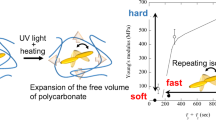Play all audios:

ABSTRACT The conformation of a photoresponsive polymer bearing azo units in the main chain, poly(propionaldehyde azine) (PrAz), in tetrahydrofuran was investigated by viscosity measurements
before and after _trans_-to-_cis_ photoisomerization and also by the rotational isomeric state (RIS) model. Before photoisomerization (_i.e._, in the case of _trans_-pPrAz), viscosity data
indicated that pPrAz took a more extended conformation than did a diene polymer analog poly(butadiene). The RIS model analysis revealed that the extended conformation of pPrAz arose mainly
from the difficulty of gauche conformation around the carbon-carbon bond in the main chain. After _trans_-to-_cis_ photoisomerization (_i.e._, in the case of pPrAz consisting of _trans_ and
_cis_ units), viscosity data indicated that the photoisomerization led to a slight extension of the pPrAz chain. The RIS model analysis explained that the photoisomerization formed
preferentially the anti-_cis_ isomer, resulting in a larger characteristic ratio to avoid severe steric hindrance between the ethyl groups on neighboring main-chain carbon atoms. SIMILAR
CONTENT BEING VIEWED BY OTHERS PHOTOINDUCED PLASTICIZING EFFECT OF THE ADDITION OF AZOBENZENE ON THE GLASS TRANSITION TEMPERATURE AND MECHANICAL PROPERTIES OF POLYCARBONATE Article 06
January 2022 CONFIGURATIONAL HEAT CAPACITY OF VARIOUS POLYMERS ABOVE THE GLASS TRANSITION TEMPERATURE Article 25 November 2021 CONFORMATIONS OF HYDROGENATED RING-OPENED POLY(NORBORNENE)S IN
DILUTE SOLUTION Article 19 December 2023 ARTICLE PDF REFERENCES * For example: K. Kinbara and T. Aida, _Chem. Rev._, 105, 1377 (2005), and references therein. * For example: a) S. Yagai, T.
Karatsu, and A. Kitamura, _Chem. Eur. J._, 11, 4054 (2005). * J.-P. Collin and J.-P. Sauvage, _Chem. Lett._, 34, 742 (2005). * M. Irie, Y. Hirano, S. Hashimoto, and K. Hayashi,
_Macromolecules_, 14, 262 (1981). * M. Irie and W. Schnabel, _Macromolecules_, 14, 1246 (1981). * A. Harada, H. Fujii, and M. Kamachi, _Macromolecules_, 24, 5504 (1991). * A. Harada, A.
Kajiwara, H. Fuji-i, and M. Kamachi, _Polym. J._, 24, 931 (1992). * M. Kamachi, A. Kajiwara, A. Hashidzume, K. Matsuda, and A. Harada, _Des. Monomers Polym._, 7, 701 (2004). * H. Fuji-i, A.
Kajiwara, A. Harada, Y. Morishima, and M. Kamachi, _Macromolecules_, 25, 4224 (1992). * T. Curtius and E. Zinkeisen, _J. Prakt. Chem._, 58, 310 (1898). * H. Fujita, “Foundations of
Ultracentrifugal Analysis,” Wiley-Interscience, New York, 1975, VOL. 42. * M. Kurata, “Thermodynamics of Polymer Solutions,” Harwood Academic Publishers: Chur, Switzerland, 1982. * As
Kamachi _et al._5–7 reported, resonance bands due to the methyl, methylene, and methine protons in pPrAz indicated the coexistence of isomeric units, _i.e._, erythro and threo units. From
the ratio of area intensities, fractions were estimated to be _ca._ 0.65 and 0.35. In the propagation reaction, the erythro unit may be formed preferentially because of less steric hindrance
between the ethyl group on the active chain end and the ethyl group in the monomer. The rotational isomeric state model analysis supported the preferential formation of the erythro units.
Thus, it can be concluded that the fractions of erythro and threo units are _ca._ 0.65 and 0.35, respectively. * By subtracting Figure 2a from Figure 2b, the fractions of erythro and threo
units after photoirradiation were confirmed to be practically the same as those before photoirradiation. * H. Yamakawa, “Helical Wormlike Chains in Polymer Solutions,” Springer, Berlin,
1997. * R. H. Colby, L. J. Fetters, and W. W. Graessley, _Macromolecules_, 20, 2226 (1987). * J. E. Mark, _J. Am. Chem. Soc._, 88, 4654 (1966). * J. E. Mark, _J. Am. Chem. Soc._, 89, 6829
(1967). * H. Fujita, “Polymer Solutions,” Elsevier, Amsterdam, the Netherlands, 1990, VOL. 9. * J. E. Kilpatrick and K. S. Pitzer, _J. Res. Natl. Bur. Stand._, 37, 163 (1946). * D. R. Lide,
Jr. and D. E. Mann, _J. Chem. Phys._, 27, 868 (1957). * D. R. Lide, Jr. and H. Eyring, _Annu. Rev. Phys. Chem._, 15, 225 (1964). * Upon _trans_-to-_cis_ photoisomerization, the syn- and
anti-_trans_ units are converted into the anti- and syn-_cis_ units, respectively, while the erythro and threo configurations are maintained. Thus, the fractions of erythro and threo units
were fixed at 0.65 and 0.35, respectively, upon calculation of _C_∞ for pPrAz after photoisomerization. Download references AUTHOR INFORMATION AUTHORS AND AFFILIATIONS * Department of
Macromolecular Science, Graduate School of Science, Osaka University, 1-1 Machikaneyama-cho, Toyonaka, 560-0043, Japan Akihito Hashidzume, Yusuke Ueno & Takahiro Sato Authors * Akihito
Hashidzume View author publications You can also search for this author inPubMed Google Scholar * Yusuke Ueno View author publications You can also search for this author inPubMed Google
Scholar * Takahiro Sato View author publications You can also search for this author inPubMed Google Scholar CORRESPONDING AUTHOR Correspondence to Takahiro Sato. RIGHTS AND PERMISSIONS
Reprints and permissions ABOUT THIS ARTICLE CITE THIS ARTICLE Hashidzume, A., Ueno, Y. & Sato, T. Conformational Analysis of Poly(propionaldehyde azine) in Dilute Solution. _Polym J_ 38,
1152–1159 (2006). https://doi.org/10.1295/polymj.PJ2006066 Download citation * Received: 30 June 2006 * Accepted: 22 August 2006 * Published: 04 October 2006 * Issue Date: 01 November 2006
* DOI: https://doi.org/10.1295/polymj.PJ2006066 SHARE THIS ARTICLE Anyone you share the following link with will be able to read this content: Get shareable link Sorry, a shareable link is
not currently available for this article. Copy to clipboard Provided by the Springer Nature SharedIt content-sharing initiative KEYWORDS * Conformational Analysis * Characteristic Ratio *
Viscometry * Sedimentation Equilibrium * Poly(propionaldehyde azine) * Photoisomerization
